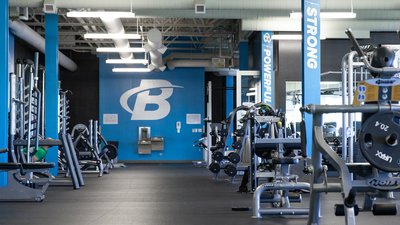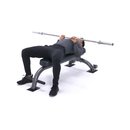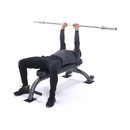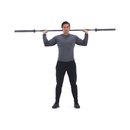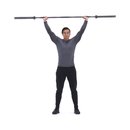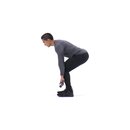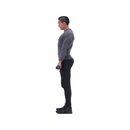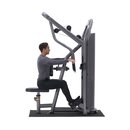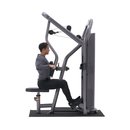If you listen to conventional bodybuilding and strength training wisdom, you probably believe that lifting for size and lifting for strength are totally separate endeavors. For decades, gurus and gym rats alike have been parroting the same old "3-5 reps for strength, 10-12 reps for size" mantra, and few people seem to question it.
Know what? I think it's bullshit.
Have you ever seen a guy with huge legs, a broad back, and a massive chest who couldn't put up some serious weight? On the other hand, how often do you see skinny guys lifting more than the experienced bodybuilders? Sure, you'll see a 180-pound monster every now and again who can bench 405 or squat more than 600, but for the most part, size and strength go hand in hand.
The truth is that training for size and training for strength are basically the same. Instead of thinking about any single rep range as a "strength builder" or "size builder," use them all to your advantage to train every fiber in your body and elicit maximal growth!
The Multiple Rep Range Program
Beyond Periodization
Periodization is the practice of transitioning from higher reps and lower weights to lower reps and higher weights (and vice versa)—over the course of a planned training cycle. It's an effective, proven technique that's long been used by powerlifters, weightlifters, and other strength athletes. But I think there's a better way, at least for the more physique-oriented trainee.
Since each rep range is going to affect your strength, size, and overall look a bit differently—and because one isn't more valuable than another—I favor a routine that includes them all in every workout. Instead of transitioning from one rep range to the next, I like to constantly improve my numbers in a variety of rep schemes, only taking steps back when my body needs a break.
Keep in mind, this may not be the optimal plan if you're specialized or purely focused on powerlifting, but I find it yields the best results for maximum muscle size, strength, density, and tone. If you want that hard, constantly flexed look that experienced bodybuilders all seem to have, then you need to use multiple rep ranges.
Your Main Lifts
Of course, we can't talk about rep ranges and progression schemes without actually discussing the lifts you'll be performing. Think you'll get away with doing nothing but leg presses for legs, machines for chest, and wimpy pull-downs for back? Think again!
I know some bodybuilders claim they get better fiber recruitment and mind-muscle connection with machines. That's great for super-advanced guys, but if you aim to gain slabs of muscle, you need to do the big, basic lifts which tax your body and mind the most and place the greatest demand on your body to grow! These basic lifts are the squat, deadlift, bench press, and overhead press.
Don't worry, you'll do more than just those four movements in this program, but they make up the four cornerstones of your training. You can certainly pick variations as long, as they allow you to use lots of weight and make relatively quick progress! You can't chicken-out and substitute light dumbbell lunges for squats, for instance, but you can pick between high-bar and low-bar squats, vary your foot placement, depth, and other factors.
The same goes for the other moves: You might do incline or decline press instead of the regular bench press, sumo deadlifts rather than conventional, and do seated instead of standing military presses. Just make sure you stick with one choice per movement pattern for at least a couple of months at a time, otherwise you won't be able to gauge your progress and gains.
Choosing Your Reps
The rep ranges you utilize will vary based on experience level. Most lifters do best with three ranges: 3-5 reps, 6-8 reps, and 9-12 reps. If you're a rank beginner who still doesn't have great technique and a feel for each lift, you need to increase those rep numbers a bit—to 6-8, 9-12, and 13-15 reps.
I don't like prescribing one-rep max percentages to determine how much you should lift for each rep range because some people can do a lot more reps with a given percentage than others. So here's a good rule: No matter which rep range you use, always aim to leave one more rep in the tank. This means you should never miss a rep in training unless you're testing your max.
In general, you should finish each set feeling like you probably could have just barely put up one more. Trust me, you'll do enough overall work that you won't need to blow a gasket on each and every set. You want to stay somewhat fresh and ensure progression from one workout to the next.
"Bodybuilding" Work
While those four basic lifts are by far the most important aspects of your program, you still don't want to leave out your accessory work. Weightlifters might call this "bodybuilding work," but in my opinion, just about any athlete who needs to get bigger and stronger should do these movements. Accessory movements are things like pull-ups, abdominal work, calf raises, biceps curls, and the like. The point of these movements is to "fill in the gaps" left by the four main movements.
There are hundreds, if not thousands of different accessory movements you can choose. So your accessory work is basically up to you. I will say, however, there are a few rules to follow:
- Your upper-back work should include barbell rows, dumbbell rows, pull-ups (not pull-downs), and maybe some shrugs if the deadlifts aren't doing enough to build your traps.
- For your arms, use variations on the curl, triceps extension, and rear-delt raise—don't do the same movements over and over.
- For lower body, you'll need heavy calves and abs exercises as well as a couple of additional moves for quads and hamstrings. As much I love the squat, you'll probably run out of steam too soon if you try to do nothing but squats for your legs, so don't be afraid to use the leg press or hack squat machines once your core (and mind) are too fried to do another set of squats.
The Program—Finally!
Alright, here's the basic template. The most important things here are the basic movement patterns, the rep ranges, and the progression of weight and reps from week to week. Remember, you can sub in other exercises or exercise variations as long as they meet the same goals. Rest for a couple of minutes or as long as necessary between sets, because these sets will make you feel like you've been hit by a truck!

BodyFit
$6.99/month- 2,500+ expert-created single workouts
- 3,500+ how-to exercise videos
- Detailed workout instruction
- Step-by-step workout tips
- Training at gym or at home
- Access to Workout Plans
- Access to Bodyfit App
- Store Discounts
Already have a Bodybuilding.com account with BodyFit? Sign In

What comes with BodyFit?

- Instructional Videos
Don't risk doing a workout improperly! Avoid injury and keep your form in check with in-depth instructional videos.

- How-to Images
View our enormous library of workout photos and see exactly how each exercise should be done before you give it a shot.

- Step-by-Step Instructions
Quickly read through our step-by-step directions to ensure you're doing each workout correctly the first time, every time.

BodyFit
$6.99/month- 2,500+ expert-created single workouts
- 3,500+ how-to exercise videos
- Detailed workout instruction
- Step-by-step workout tips
- Training at gym or at home
- Access to Workout Plans
- Access to Bodyfit App
- Store Discounts
Already have a Bodybuilding.com account with BodyFit? Sign In

What comes with BodyFit?

- Instructional Videos
Don't risk doing a workout improperly! Avoid injury and keep your form in check with in-depth instructional videos.

- How-to Images
View our enormous library of workout photos and see exactly how each exercise should be done before you give it a shot.

- Step-by-Step Instructions
Quickly read through our step-by-step directions to ensure you're doing each workout correctly the first time, every time.
Day 3: Off

BodyFit
$6.99/month- 2,500+ expert-created single workouts
- 3,500+ how-to exercise videos
- Detailed workout instruction
- Step-by-step workout tips
- Training at gym or at home
- Access to Workout Plans
- Access to Bodyfit App
- Store Discounts
Already have a Bodybuilding.com account with BodyFit? Sign In

What comes with BodyFit?

- Instructional Videos
Don't risk doing a workout improperly! Avoid injury and keep your form in check with in-depth instructional videos.

- How-to Images
View our enormous library of workout photos and see exactly how each exercise should be done before you give it a shot.

- Step-by-Step Instructions
Quickly read through our step-by-step directions to ensure you're doing each workout correctly the first time, every time.

BodyFit
$6.99/month- 2,500+ expert-created single workouts
- 3,500+ how-to exercise videos
- Detailed workout instruction
- Step-by-step workout tips
- Training at gym or at home
- Access to Workout Plans
- Access to Bodyfit App
- Store Discounts
Already have a Bodybuilding.com account with BodyFit? Sign In

What comes with BodyFit?

- Instructional Videos
Don't risk doing a workout improperly! Avoid injury and keep your form in check with in-depth instructional videos.

- How-to Images
View our enormous library of workout photos and see exactly how each exercise should be done before you give it a shot.

- Step-by-Step Instructions
Quickly read through our step-by-step directions to ensure you're doing each workout correctly the first time, every time.

BodyFit
$6.99/month- 2,500+ expert-created single workouts
- 3,500+ how-to exercise videos
- Detailed workout instruction
- Step-by-step workout tips
- Training at gym or at home
- Access to Workout Plans
- Access to Bodyfit App
- Store Discounts
Already have a Bodybuilding.com account with BodyFit? Sign In

What comes with BodyFit?

- Instructional Videos
Don't risk doing a workout improperly! Avoid injury and keep your form in check with in-depth instructional videos.

- How-to Images
View our enormous library of workout photos and see exactly how each exercise should be done before you give it a shot.

- Step-by-Step Instructions
Quickly read through our step-by-step directions to ensure you're doing each workout correctly the first time, every time.
Day 7: Off
The Progression Scheme
Since there's no traditional periodization here, your progression from one workout to the next is going to be simple. For your main lifts, add 5 pounds to the bar for each rep range every workout. Once you're not able to get at least the bottom-end number of reps for any particular rep range, take 15 pounds off the bar (yes, I said 15) and start anew. You will be able to get more reps immediately and, in a few weeks, blow past your old sticking point.
For your secondary lifts—and any others for which you'll do four sets of 10-20 reps—keep using the same weight until you're able to get at least 15 reps for all four sets in the same workout. At that point, you can increase the weight, but not by so much that you can't stay within the 10-20 range for all four sets.
Finally, for all of the upper-back work, use as much weight as you can without sacrificing form or missing reps. Ideally, you'd use the same weight for all four sets, but don't worry if you have to lighten the load for the third or fourth set to stay within the rep range. Once you hit near the top of the range for all four sets, it's time to go heavier!
Let's Go To Work!
Seems almost too simple, doesn't it? But that's how your training should be, at least most of the time! Far too many new lifters spend hours upon hours over-thinking their programs. Smart training is essential, but your progression should rely on consistent hard work, not some overwrought, pseudo-scientific program. The greatest lifters—whether they've competed in powerlifting or bodybuilding—have busted their asses with simple programs to reach their level of success.


